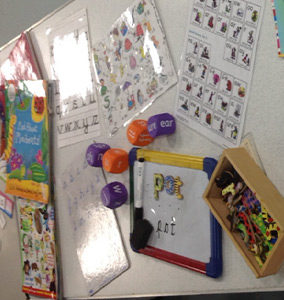At Dean Field School we believe that reading is the most important thing that children learn at school.
Reading is the key to future success.
Learning to read is like learning a code and the letters are the symbols for the code. If you know what the symbols mean you can crack the code.
In September 2018 Dean Field School started to use a scheme called Read Write Inc. This scheme had been devised by Ruth Miskin. Ruth devised the scheme when she was a headteacher in inner London in a school where reading was a real issue. Her results were remarkable.
Read Write Inc. teaches synthetic phonics in a structured exciting way. Children will start the scheme when they join the school in Nursery and will work through the scheme until they can read confidently with good understanding. The scheme also supports children’s writing, giving them the tools to spell and compose.
What is synthetic phonics?
When your child is learning to read there are two crucial things to learn:
– the sounds represented by written letters
– how to blend the sounds together to make words. Synthetic Phonics is a way of teaching reading.
Children are taught to read letters or groups of letters by saying the sound(s) they represent – so, they are taught that the letter l sounds like llllll when we say it. Children can then start to read words by blending (synthesising) the sounds together to make a word.
Say the sounds
There are 26 letters of the alphabet but they make 44 sounds. Please take some time to watch the following videos that explain how you can help your child to learn to read.
Please click the link to watch and listen to further phonics information and support.
An overview of Read, Write, Inc.
Correct pronunciation of the sounds.
Some words cannot be ‘sounded-out’ as they do not follow the phonics rule. Examples of these are ‘the’, ‘into’, ‘magic’, ‘come’. Therefore these are taught as Red words within Read, Write, Inc. We teach them as sight words and the more children are exposed to them, the more they are instilled in their working memory.
Bookbag Books
At Dean Field we have invested in the bookbag books which relate to the Read, Write, Inc. scheme we teach. This means the book your child brings home will always contain sounds and words they have already been taught in school so at home they can practise these confidently. This will help them to consolidate and retain their phonics learning, making them masters of reading! If your child is ready to take part in Accelerated Reader then this will run alongside the Read, Write, Inc. bookbag books. Even the best of readers will continue to be introduced to a variety of phonics sounds so we feel it is important for this to be practised and retained for future learning.

Although we follow the Read, Write, Inc. scheme for phonics there are still many other resources you can use online and at home to support your child’s reading skills. Some websites include:
- phonicsplay.co.uk
- https://www.ictgames.com/mobilePage/literacy.html
- https://www.topmarks.co.uk/english-games/5-7-years/letters-and-sounds
Games which can be made or played around your home include:
- I-spy – Use the sound not alphabet name. This can also be extended to segmenting the word – “I spy with my little eye a ‘c-a-t’”.
- Splat – On a big piece of paper or old bed sheet, write the sounds spaced out. Call a sound out and your child needs to splat it using a fly swatter or other similar tool. This can also be extended to words rather than just sounds.
- Hide and Seek – Using plastic cups or other similar containers, turn them upside down and record a sound on each one. Hide a small toy or something similar underneath a cup without your child seeing. They have to say the sound on the cup before lifting it up, continue until they find the hidden object. This can also be extended to words rather than just sounds.
- Sound hunt – Record the sounds on individual paper or something similar. Hide the sounds around the environment, challenge them to see how many they can find. They can only hand it in if they correctly say the sound. This can also be extended to words rather than just sounds.
- Roll and Read – Create a table 6×6 with numbers 1-6 in the left hand side column. Enter different sounds in the remaining spaces. Roll a dice or generate a number 1-6. Read a sound within that number’s row and place a counter or something similar to show it’s been read. Compete until the board is full. This can also be extended to words rather than just sounds.
- Missing letter – Write a word (include picture to make easier) and hide one of the letters. Adult to say the word. Child to work out the sound missing.
- Flashcards – Record the sounds on different materials e.g. card, flash them up – this works well with games such as snap and pairs too. This can also be extended to words rather than just sounds.



Each year we run a Phonics workshop (virtually or in school depending on restrictions). Here are some of the activities the children and their families enjoyed taking part in.





